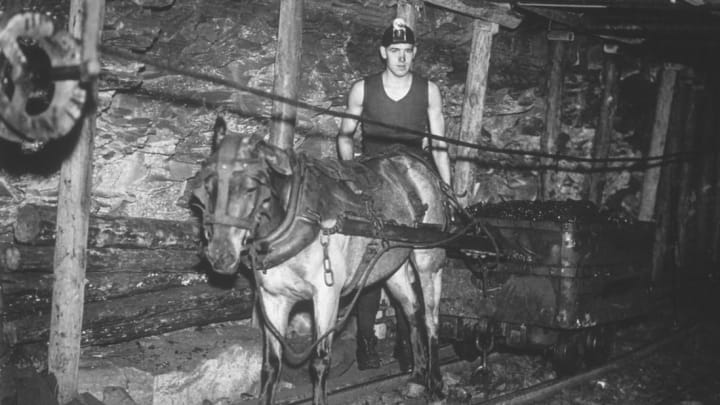As cute and cuddly as miniature horses are, their work history is more complex than giving children rides at birthday parties or carting around small carriages. In 1838, the Huskar Colliery coal mine in northern England flooded, drowning 26 children who were working in the depths of the mine as trappers and hurriers. Queen Victoria demanded an inquiry, and within a few years, Parliament passed an act banning children under 10 years old (and women) from working underground as coal miners. Although the Mines Act of 1842 was a boon to child workers, it meant that the mining industry needed a way to replace all those tiny workers. The answer was to greatly increase the number of mini horses, called pit ponies, used to work in the mines. Today’s American Miniature Horses—defined as small yet proportional horses that measure 34 inches or less—descend from the bloodline of these pit pony coal miners.
Pit ponies’ strength made them able to pull heavy carts, and their small size allowed them to maneuver in cramped mine conditions. In 1913, as many as 70,000 pit ponies worked underground in Britain’s coal mines. Different breeds were suited to different mining activities. For example, Shetland ponies’ strength, sturdiness, and intelligence made them well suited for carrying coal over rough, uneven terrain, while donkeys and mules were more common in Pennsylvania mines. Likewise, different types of coal necessitated differing work conditions for the ponies. For instance, pit ponies in bituminous (soft black coal) collieries in Wales were stabled above ground and could walk in and out of tunnels constructed on sloping hills. Other ponies that worked to extract anthracite (hard) coal had to be put in a cage and lowered into the shaft mines. Any time all the workers in a particular mine went on strike or took vacation, every pony had to be lifted back up above ground, one by one.
The National Coal Board strictly regulated the use of pit ponies as mine workers, and the British Coal Mines Act of 1911 required that before they could start work, ponies had to be at least 4 years old, examined by a veterinarian, and fit with proper horseshoes. Most ponies worked 8-hour days and were paired up with one miner/handler, so that human and horse could build a trusting, long-term relationship. Although a few reports suggest that some pit ponies were mistreated, the majority of ponies seem to have been treated well. They slept in clean stables, ate a plentiful supply of corn or hay, drank fresh water, and worked fewer hours as they aged (most lived until their late teens or early 20s).

A pit pony in 1920. Central Press // Getty Images
Although technological advances eventually made pit ponies obsolete, the small horses still carried coal in small, private mines in Europe, and in Appalachia in the United States, until the 1950s. In the 1960s, the Royal Society for the Prevention of Cruelty to Animals worked with the National Coal Board to help find homes for retired pit ponies. Retirement came with its own set of challenges, for pit ponies were unaccustomed to living above ground in "normal" conditions, sans work schedules and handlers. Some of these equine retirees became stressed since they didn’t even know how to graze on grass. However, at least they got to live above ground rather than be sold for horse meat, a humane way for these ponies, who helped generate electricity and power civilization, to spend their last days.
